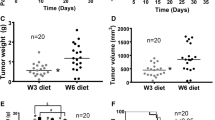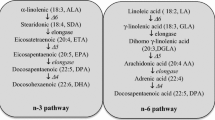Abstract
Objective
The aim of this study was to determine whether α-linolenic acid (ALA ω-3 fatty acid) enriched diet affects growth parameters when applied to a syngeneic model of mammary carcinoma.
Materials and methods
BALB/c mice were divided and fed with: 1) a chia oil diet, rich in ALA or 2) a corn oil diet, rich in linoleic acid (LA ω-6 fatty acid). Mice were subcutaneously inoculated with a tumor cell line LM3, derived from a murine mammary adenocarcinoma.
Results
After 35 days, tumor incidence, weight, volume and metastasis number were lower in the ALA-fed mice, while tumor latency time was higher, and the release of pro-tumor metabolites derived from ω-6 fatty acids decreased in the tumor. Compared to the control group, a lower number of mitosis, a higher number of apoptotic bodies and higher T-lymphocyte infiltration were consistently observed in the ALA group. An ALA-rich diet decreased the estrogen receptor (ER) α expression, a recognized breast cancer promotor while showing an opposite effect on ERβ in tumor lysates.
Conclusion
These data support the anticancer effect of an ALA-enriched diet, which might be used as a dietary strategy in breast cancer prevention.






Similar content being viewed by others
References
Ronco AL, De Stéfani E, Stoll M (2010) Hormonal and metabolic modulation through nutrition: towards a primary prevention of breast cancer. Breast 19(5):322–332
Lelièvre SA, Weaver CM (2013) Global nutrition research: nutrition and breast cancer prevention as a model. Nutr Rev 71(11):742–752
Eynard AR (2003) Potential of essential fatty acids as natural therapeutic products for human tumors. Nutrition 19(4):386–388
Serhan CN (2014) Pro-resolving lipid mediators are leads for resolution physiology. Nature 510(7503):92–101
Subedi K, Yu HM, Newell M, Weselake RJ, Meesapyodsuk D et al (2015) Stearidonic acid-enriched flax oil reduces the growth of human breast cancer in vitro and in vivo. Breast Cancer Res Treat 149(1):17–29
Cho K, Mabasa L, Fowler AW, Walsh DM, Park CS (2010) Canola oil inhibits breast cancer cell growth in cultures and in vivo and acts synergistically with chemotherapeutic drugs. Lipids 45(9):777–784
Muñoz SE, Silva RA, Lamarque A, Guzman CA, Eynard AR (1995) Protective capability of dietary Zizyphus mistol L. seed oil, rich in 18:3 n-3, on the development of two murine mammary gland adenocarcinomas with high or low metastatic potential. Prostagl Leuk Essent Fat Acids 53:135–138
Banno N, Akihisa T, Tokuda H, Yasukawa K, Higashihara H et al (2004) Triterpene acids from the leaves of Perilla frutescens and their anti-inflammatory and antitumor-promoting effects. Biosci Biotechnol Biochem 68(1):85–90
Espada CE, Berra MA, Martinez MJ, Eynard AR, Pasqualini ME (2007) Effect of chia oil (Salvia hispanica) rich in w-3 fatty acids on the eicosanoid release, apoptosis and T-lymphocyte tumor infiltration in a murine mammary gland adenocarcinoma. Prostagl Leuk Essent Fat Acids 77:21–28
Gleissman H, Johnsen JI, Kogner P (2010) Omega-3 fatty acids in cancer, the protectors of good and the killers of evil? Exp Cell Res 316(8):1365–1373
Lu IF, Hasio AC, Hu MC, Yang FM, Su HM (2010) Docosahexaenoic acid induces proteasome-dependent degradation of estrogen receptor alpha and inhibits the downstream signaling target in MCF-7 breast cancer cells. J Nutr Biochem 21(6):512–517
Fox EM, Davis RJ, Shupnik MA (2008) ERβ in breast cancer—onlooker, passive player, or active protector? Steroids 73(11):1039–1051
Herynk MH, Fuqua SA (2004) Estrogen receptor mutations in human disease. Endocr Rev 25:869–898
Puricelli L, Colombo LL, Bal de Kier Joffé E, de Lustig ES (1984) Invasiveness in vitro of two mammary adenocarcinoma tumors with different metastasizing ability. Invasio Metast 4:238–246
Folch J (1957) A simple method for the isolation and purification of total lipids from animal tissue. J Biol Chem 226:497–509
Pasqualini ME, Berra MA, Calderón RO, Cremonezzi D, Giraudo C et al (2005) Dietary lipids modulate eicosanoid release and apoptosis of cells of a murine lung alveolar carcinoma. Prostagl Leuk Essent Fat Acids 72:235–240
Lowry OH, Farr AL, Randall RJ (1951) Protein measurement with the Folin phenol reagent. J Biol Chem 193(1):265–275
Toniolo A, Warden EA, Nassi A, Cignarella A, Bolego C (2013) Regulation of SIRT1 in vascular smooth muscle cells from streptozotocin-diabetic rats. PLoS One. 8(5):e65666
Hosek J, Toniolo A, Neuwirth O, Bolego C (2013) Prenylated and geranylated flavonoids increase production of reactive oxygen species in mouse macrophages but inhibit the inflammatory response. J Nat Prod 76(9):1586–1591
American Oil Chemists’ Society (1998) Official methods and recommended practices of the AOCS. American Oil Chemists’ Society, Champaign
Rathore AS, Kumar S, Konwar R, Makker A, Negi MP et al (2014) CD3+, CD4+ and CD8+ tumour infiltrating lymphocytes (TILs) are predictors of favourable survival outcome in infiltrating ductal carcinoma of breast. Indian J Med Res 140(3):361–369
Liu S, Edgerton SM, Moore DH 2nd, Thor AD (2001) Measures of cell turnover (proliferation and apoptosis) and their association with survival in breast cancer. Clin Cancer Res 7(6):1716–1723
Corsetto PA, Montorfano G, Zava S, Jovenitti IE, Cremona A et al (2011) Effects of n-3 PUFAs on breast cancer cells through their incorporation in plasma membrane. Lipids Health Dis 12(10):73
Larsson SC, Kumlin M, Ingelman-Sundberg M, Wolk A (2004) Dietary long-chain n-3 fatty acids for the prevention of cancer: a review of potential mechanisms. Am J Clin Nutr 79:935–945
Corsetto PA, Cremona A, Montorfano G, Jovenitti IE, Orsini F et al (2012) Chemical-physical changes in cell membrane microdomains of breast cancer cells after omega-3 PUFA incorporation. Cell Biochem Biophys 64:45–59
Williams JA, Batten SE, Harris M, Rockett BD, Shaikh SR et al (2012) Docosahexaenoic and eicosapentaenoic acids segregate differently between raft and nonraft domains. Biophys J 103:228–237
Wallace JM (2002) Nutritional and botanical modulation of the inflammatory cascade-eicosanoids, cyclooxygenases, and lipoxygenases-as an adjunct in cancer therapy. Integr Cancer Ther 1:7–37
Cabral M, Martín-Venegas R, Moreno JJ (2013) Role of arachidonic acid metabolites on the control of non-differentiated intestinal epithelial cell growth. Int J Biochem Cell Biol 45:1620–1628
Hsi LC, Wilson L, Nixon J, Eling TE (2001) 15-lipoxygenase-1 metabolites down-regulate peroxisome proliferator-activated receptor gamma via the MAPK signaling pathway. J Biol Chem 276(37):34545–34552
Zhang G, Panigrahy D, Mahakian LM, Yang J, Liu JY et al (2013) Epoxy metabolites of docosahexaenoic acid (DHA) inhibit angiogenesis, tumor growth, and metastasis. Proc Natl Acad Sci USA 110(16):6530–6535
Serhan CN (2011) The resolution of inflammation: the devil in the flask and in the details. FASEB J 25:1441–1448
Coronella JA, Spier C, Welch M, Trevor KT, Stopeck AT et al (2002) Antigen-driven oligoclonal expansion of tumor-infiltrating B cells in infiltrating ductal carcinoma of the breast. J Immunol 169:1829–1836
Toso JF, Oei C, Oshidari F, Tartaglia J, Paoletti E et al (1996) MAGE-1-specific precursor cytotoxic T-lymphocytes present among tumor-infiltrating lymphocytes from a patient with breast cancer: characterization and antigen-specific activation. Cancer Res 56:16–20
Rabinowich H, Cohen R, Bruderman I, Steiner Z, Klajman A (1987) A functional analysis of mononuclear cell infiltrating into tumors: lysis of autologous human tumor cells by cultured infiltrating lymphocytes. Cancer Res 47:173–177
Yuan B, Cheng L, Chiang HC, Xu X, Han Y, Su H, Wang L et al (2014) A phosphotyrosine switch determines the antitumor activity of ERβ. J Clin Invest 124(8):3378–3390
Acknowledgements
We are indebted to Mr. Ricardo Mattos (Instituto de Biologìa Celular, FCM-UNC) for animal care, Gina Madzzudulli (INICSA-CONICET) for immunohistochemistry, and Andrea Pagetta (PhD) for technical assistance with the microscope analysis (University of Padua). We also thank to Martin Fernandez-Zapico (MD) for critical review. Prof. Mirta A. Valentich acknowledges the support from Ministerio de Ciencia y Tecnología de Córdoba, Argentina (MINCYT) Secretaría de Ciencia y Tecnología de la Universidad Nacional de Córdoba (SECyT-UNC) and Consejo Nacional de Investigaciones Científicas y Técnicas (CONICET). Prof. Chiara Bolego and Lucia Trevisi (PhD) acknowledge the support from institutional funding of the University of Padova.
Author information
Authors and Affiliations
Corresponding author
Ethics declarations
Conflict of interest
The author states that there is no conflict of interest.
Ethical approval
All applicable international, national, and/or institutional guidelines for the care and use of animals were followed.
Additional information
An erratum to this article is available at http://dx.doi.org/10.1007/s00394-016-1174-4.
Electronic supplementary material
Below is the link to the electronic supplementary material.
Rights and permissions
About this article
Cite this article
Vara-Messler, M., Pasqualini, M.E., Comba, A. et al. Increased dietary levels of α-linoleic acid inhibit mammary tumor growth and metastasis. Eur J Nutr 56, 509–519 (2017). https://doi.org/10.1007/s00394-015-1096-6
Received:
Accepted:
Published:
Issue Date:
DOI: https://doi.org/10.1007/s00394-015-1096-6




